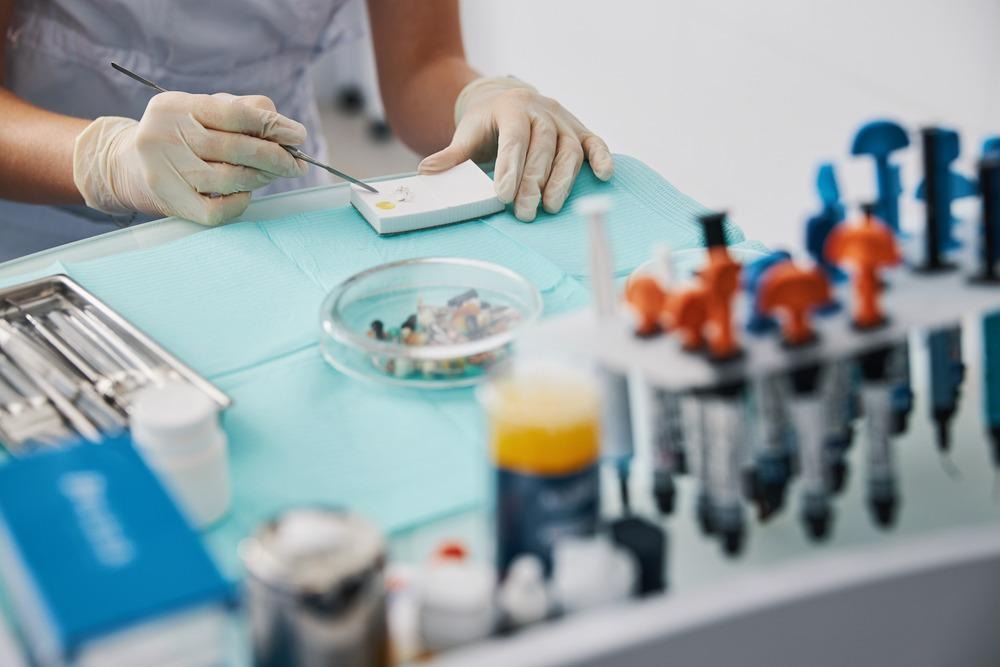In recent years dental materials have evolved, which has changed dental practice and treatment planning significantly. This article provides an overview of bioactive dental materials, their advantages, and their applications in various dentistry fields.

Image Credit: kksakultap/Shutterstock.com
How Bioactive Materials are Defined
Biocompatibility and bioactivity are the two terms commonly used in dentistry. Generally, biocompatible materials are those materials that are well-tolerated by the biological system, whereas bioactive materials produce local physiological responses through chemical or physical action.
Today, with the latest developments in bioactive materials, the definition of these materials depends upon the applications. For instance, in restorative dentistry, a material’s capability of forming hydroxyapatite crystals on the surface is known as a bioactive property. In implantology, bioactivity refers to the ability of a substance to form a chemical bond with the recipient bone and the implant.
Similarly, these materials are used to remineralize the enamel surface in preventive dentistry.
Bioactive Materials in Endodontics
MTA-based Materials
In endodontics, one of the first materials to have the properties of a bioactive material was calcium hydroxide, which was used for assisting the development of a dentinal bridge on pulp tissue. Mineral trioxide aggregate (also generally known as MTA) and its derivates were developed later on, and these are commonly used now.
MTA-based materials are calcium silicate agents that include a mixture of portland cement with opacifier bismuth oxide. These materials are advantageous due to their hydraulic nature, which assists their functions in a moist environment like root canals.
Bioceramics and their Applications
Hydraulic cement, also known as bioceramic, is bioactive because it has the capability to form hydroxyapatite crystals. These crystals are formed on the surface of hydraulic cement when phosphate ions from body fluids precipitate with calcium ions. Applications of these bioceramics are vast. Nowadays, these are used in root canal filling, apexification, pulp capping, apexogenesis, perforation repair, and as endodontic sealers.
Bioactive Materials in Restorative Dentistry
In restorative dentistry, glass ionomer (fluoride-releasing restorative material) is considered to be among the first bioactive compounds. However, in restorative dentistry, bioactivity is not necessarily the desired property of restorative materials due to the induced formation of hydroxyapatite on the bioactive material’s surface.

Image Credit: YAKOBCHUK VIACHESLAV/Shutterstock.com
Calcium build-up on the surface can be caused by the biomineralization of restorations. This feature might be beneficial to the tooth tissue, since bioactive compounds would inhibit matrix metalloproteinase enzymes and enhance the hybrid layer.
Calcium Aluminate and Calcium Silicate-Based Cement
Calcium aluminate and calcium silicate are commonly used bioactive compounds for restorative dentistry. These compounds have various applications depending upon their usage. Biodentine is a calcium silicate-based cement with MTA-like clinical indications and can be used as a temporary restorative material, whereas calcium aluminate restorative materials include direct restorative material and luting cement.
Bioactive Materials in Implantology
In implantology, these compounds are used as coatings to enhance osseointegration of dental implants, increasing their overall performance. These implants are made up of bioinert substances like cobalt-chromium alloys, titanium alloy Ti-6Al-4V, and stainless steel 316L. For coating these implants with bioactive materials, various techniques and methods are used, for example, enameling, laser cladding, sol-gel technique, thermal spraying, and electrophoresis.
The first bioactive glass was made about five decades ago, named 45S5. Zinc oxide, zirconium dioxide, hydroxyapatite, and titanium dioxide are other bioactive coatings that are commonly used in implantology. Their properties can be improved further by the addition of active agents. For example, the antibacterial properties of bioactive glass are enhanced when silver ions are added.
Conclusion
Dental materials are evolving considerably, which has improved dental practice and treatment planning significantly. If we compare bioactive materials to inert material, the former has the capability to produce growth factors and natural mineralization. These, therefore, provide better alternatives to conventional dental materials.
Moreover, with vast applications of bioactive materials, the research is shifting towards bioactivity rather than biocompatibility. The latest dental materials that are used in modern dentistry have properties like biocompatibility, biomimetic, and bioactivity, and applications in various areas of dentistry like restorative dentistry, endodontics, and implantology.
References and Further Reading
Goldstep, F., 2018. Bioactivity In Restorative Dentistry: A User’s Guide - Oral Health Group. [online] Oral Health Group. Available at: <https://www.oralhealthgroup.com/features/bioactivity-restorative-dentistry-users-guide/>
Grayson, K., 2021. Bioactive vs Biocompatible: What’s the Difference?. [online] Mo-Sci Corporation. Available at: <https://mo-sci.com/bioactive-vs-biocompatible-whats-the-difference/>
Hamdy, T. M. (2018). Bioactivity: A New Buzz in Dental Materials. EC Dental Science, 17(8), 1-6. https://www.researchgate.net/publication/326345093
Spagnuolo, G. (2022). Bioactive Dental Materials: The Current Status. Materials, 15(6), 2016. https://www.mdpi.com/1996-1944/15/6/2016
Disclaimer: The views expressed here are those of the author expressed in their private capacity and do not necessarily represent the views of AZoM.com Limited T/A AZoNetwork the owner and operator of this website. This disclaimer forms part of the Terms and conditions of use of this website.